|
April 24, 2008
Presenting: Brandon Wilson - Author, Photographer
and World Traveler Shares Tales of a Pilgrim -
Part II
For several years now I have started to question life as we understand
it. For some strange reason, as I get older, things such as acquiring
the next gadget or a bigger screen TV have become a lot less important.
Like so many others, I have started to wonder what life is all about.
I may not have arrived at the definite answers yet, but I have concluded
that it's not all about consumption, materialism and the next step
up the career ladder.
Throughout my personal quest I have had the opportunity to connect
with people who have chosen a "life outside the box",
who have walked unconventional paths and come up with their own
unique formulas for a meaningful life.
Brandon Wilson is one of these people. Read here part II of his
interview. For more about his background and his many travel adventures
visit Part I of the
interview.
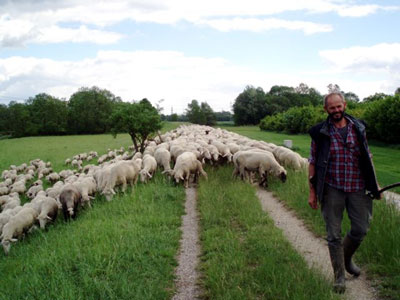
The Templar Trail follows the Danube River from Germany to Budapest.
Image © Brandon Wilson
1. Please tell us about your recent journeys on the St.
Olav's Way in Norway and the Via de la Plata.
Nearly each year now I walk another 1,000 kilometers. The more
I walk, the more I connect with a worldwide brotherhood of others
lured by similar experiences. When I return, I write travel articles
about my journeys and in turn learn about other trails.
The art of pilgrimage is part of the tapestry of all major religions,
as pilgrims traditionally traveled to sites of faith and power.
In Christianity, this practice waned during the Reformation, but
has been rediscovered as local communities resurrect these trails
for modern travelers. One such path is the St. Olav’s Way
that retraces the route of King Olav from Oslo to Trondheim as he
brought Christianity to Scandinavia. I followed that rugged wilderness
trail a few years ago. Then I walked the Camino de Santiago a second
time with my wife Cheryl, and in 2007 I traced the 1,000 km Via
de la Plata from Seville to Santiago, Spain. Its heritage is more
influenced by the Roman era and it’s certainly far less traveled
than the popular northern route.
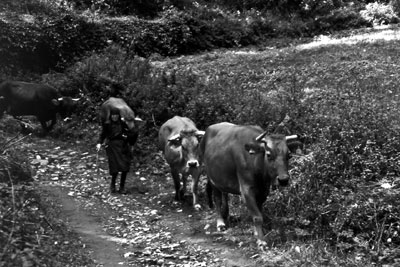
Time seems to stand still on the Via de la Plata, as settings
take on
a painterly texture. Image © Brandon Wilson
2. You chose to walk from France to Jerusalem as another
major pilgrimage experience. What motivated you to go on this journey
and what was your special goal?
A 68-year-old Frenchman I had met back on the Camino de Santiago
contacted me. He’d always dreamed about walking to Jerusalem
with his wife once she retired. To my good fortune she’d decided
not to go and he asked if I was interested taking her place. Well,
it took me all of thirty seconds to reply, “Mais, oui.”
Our route would follow that of the First Crusades and those who
were to become the first Knights Templar.
Besides viewing this 2600-mile odyssey as a personal pilgrimage,
I decided to make it a walk for peace. I’d talk to others
along the way about choosing nonviolent ways of settling our problems
rather than resorting to never-ending wars. My third reason for
walking it was to establish this trail as an international path
of peace that others might follow regardless of their nationality
or beliefs.
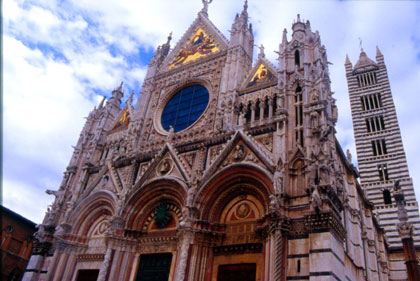
Architectural gems await discovery all along the Via Francigena,
such as the
Duomo in Siena. Image © Brandon Wilson
3. Where did this journey take you? Tell us about your experiences
in the various countries that you walked through.
Our odyssey began in Dijon, France where we followed pathways along
ancient canals. Once in southern Germany, we connected with the
Donau Radweg, or bicycle path, and followed the Danube River through
Germany, Austria and Slovakia into Budapest. From there we headed
south along more bike paths and country roads to Serbia where we
connected with what was once the old Roman road or Via Militaris.
Throughout, I found it especially ironic that our path of peace
would follow a trail used primarily for war. How fitting!
Improvisation was our constant companion. Since we were re-blazing
a thousand year old trail, everything was uncertain. Who knew where
we’d find a place to sleep or eat along the way? That was
part of the adventure. We traveled simply and without a tent, hoping
to stay in monasteries or simple hostels along the way. We budgeted
$30 a day total per person to keep within the modern pilgrim’s
budget. I carried only a fifteen-pound pack, so I didn’t have
to make too many wardrobe decisions, and again found refuge in simplicity.
Time and again we were helped by “angels,” complete
strangers who offered us food when we were hungry, water when we
were thirsty, and often a place to sleep when we could walk no farther.
Again, I was reminded how similar we all are, regardless of nationality
or culture. We all have comparable needs, hopes and dreams.
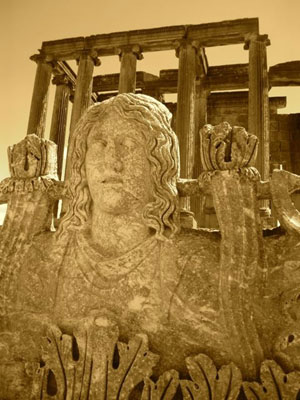
The Templar Trail is dotted with remnants from past Roman and
Greek eras.
Image © Brandon Wilson
4. Politics also interfered on this trip. How did the political
events of 2006 affect you on your pilgrimage?
Ah, politics always have a way of disrupting life. Arriving in
Belgrade, we learned that Israel had just bombed the Beirut airport
in retaliation for Hezbollah strikes. Back home, there was talk
of World War III. Would we be able to continue? If so, would we
have to change our route? Again, keep in mind, part of my reason
for attempting the long journey (the equivalent of walking from
New York to Los Angeles) was to establish a trail others might follow,
hopefully without facing bullets in the process.
We decided to continue through Serbia and Bulgaria and then weigh
our options once we reached Istanbul. However, more unforeseen events
would happen over the next month, including an attempted attack
on the US Embassy in Damascus, shootings of travelers in Amman,
and an Ebola-like virus in Turkey—not to mention the 90-degree
temperatures we faced each day between villages.
Needless to say, I didn’t die en route and eventually reached
Jerusalem, but not without incident. I’ve chronicled our entire
journey, all the ups and downs, the “angels” and characters
in my new book, Along the Templar Trail: Seven Million Steps for
Peace. It includes stages, distances, maps, photos and a gear list
for others who might follow in our footsteps.

Jerusalem is a holy city filled with strife and, some say, living
on borrowed time.
Image © Brandon Wilson
5. You have done extensive traveling in the last 20 years.
How have you restructured your life to become a full-time pilgrim,
explorer and photographer? What do you do in between trips?
Repair my feet? No, it’s important for everyone to find their
passion in life. Too many people live what Henry David Thoreau called,
“lives of quiet desperation.” We trade our lives, our
souls, for possessions to bring us happiness. Maybe there is that
illusion of pleasure for a while, but it never lasts. I believe
most people in our society would relish the idea of having more
time with their families, their friends, to develop other interests,
to explore the world. We can provide a world of excuses, but ultimately
it comes down to individual choice. Contrary to popular belief,
you can’t have it all.
My life has been a series of trade-outs. But isn’t everyone’s?
I’ve followed career paths less traveled to give me the freedom
to walk world paths less traveled. When I return to my so-called
normal life, I write articles and make appearances to share my experiences
with others. I’ve written three travel adventure books and
have collaborated on several others. As you might imagine, I take
photographs on each journey and now have thousands of shots that
I hope to release as books in the future. Even I’m trying
to find the time!
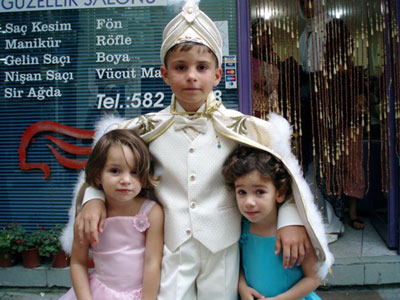
Turkish boy off to his circumcision ceremony (not smiling for
long).
Image © Brandon Wilson
6. Your wife still has a conventional job with two weeks
vacation a year. How do you manage to accommodate these different
life-styles?
Having a two-week vacation is a travesty in today’s high
stress world. How do other Western cultures manage to give workers
six weeks off each year without falling apart? It’s long past
time to change that paradigm…
To answer your question, as Cheryl put it so well in Tibet, “We’re
not joined at the hip.” Like any healthy relationship, there
is much we share and other aspects of our lives we develop on our
own. Our longevity comes down to trust and giving each other freedom
for self-realization. That said, she looks forward to the day when
she can find the same freedom of the road.
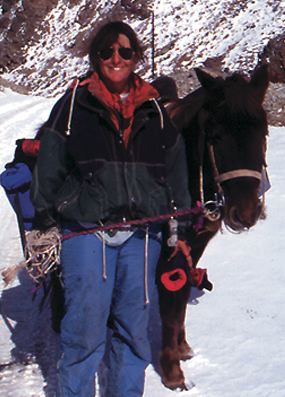
Cheryl and Sadhu adrift on wild Tibetan pass.
Image © Brandon Wilson
7. How easy or difficult is it to come back from an extensive
pilgrimage and go back to a more settled life-style? There must
have been moments of culture shock when you are re-entering your
life in North America.
It’s difficult. Each time I come home, I return a different
person. Travel changes you and your perceptions of life and the
world. Culture shock is inevitable—but it can be entertaining
if you recognize it for its shape-shifting self.
8. What do travel in general, and pilgrimages specifically
mean to you? Why do you choose long-term travel, and in particular
pilgrimages?
Travel is like holding up a mirror to the world. If you are lucky,
you will often find a reflection of yourself.
At the same time, travel enables us to look more clearly at our
own culture from afar, and in doing so it more visibly shows our
interconnectedness on this increasingly fragile planet. We are truly
a global village. Nowadays, actions in once-distant lands cause
reverberations worldwide. Smokestacks and global pollution affect
us all. Violence, greed, ignorance and poverty are modern plagues
and, if not stopped, may eventually lead to mutual destruction.
For me, a pilgrimage is a constant journey, each one building upon
the last. Walking a pilgrimage reduces life to its essentials. It’s
a chance to look within, as well as a time to communicate with a
greater power. At the end of the day, all pilgrims rub sore feet,
bandage blisters, take cold showers, and share food around the same
table. As we share stories and dreams over that bottle of Rioja,
we realize how similar we are, our hopes of peace, a homeland, health
and security for our families, a better life for our children. Everything
else is superfluous. In the final analysis, love is all there is.
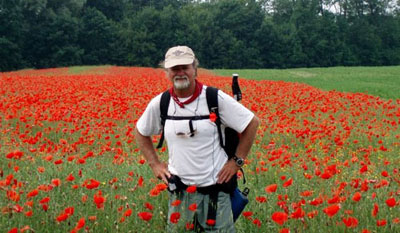
Brandon Wilson, author/pilgrim, amid the poppies of Hungary.
Image © Brandon Wilson
9. What have you learned from your travels about life,
people, politics and priorities?
That would take another book to answer. However, I talk a lot about
these lessons of the trail in all my books, especially in Along
the Templar Trail.
But briefly, I know that too often we delay celebrating our happiness,
waiting for the major coup in life: buying the status car, a MacMansion
on the hill, or the piña coladas of retirement. Instead,
we need to savor the small victories along life’s way. Live
your passion. As Mark Twain once said, “Dance like no one
is watching. Sing like no one is listening…”
Listen more and talk less. The answers are out there, if only we
can hear.
Realize what’s truly important in life and set-aside time
for families, our friendships, ourselves.
Stand firm against fear mongers who would set us up, clanging swords
against each other. Preserve the foundations of our democracy and
guard against those who would dismantle it in the name of safety.
Realize we are more alike than we are different, and that when all
men are brothers, every war is a civil war.
Peace begins with each of us. In walking, we find a personal tranquility.
Returning home, we share that peace with our families, at our jobs,
and in our communities.
As I say in the book, “We are all pilgrims, each on their
own path, each with their own story to tell. Walking is only the
first step, but one we can each take to discover the peace within.
In that way, eventually, war will become unconscionable. Darkness
will be dispelled with light—one person, one step at a time.”
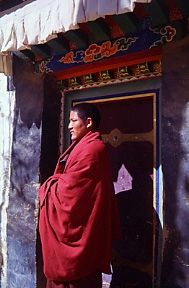
Monk at temple in Shigatse, Tibet.
Image © Brandon Wilson
10. What's in store for Brandon Wilson in the next few
months and years?
Rather than trying to demand, “This is what I want,”
I try to patiently listen and wait like a surfer pausing for that
perfect wave, knowing it will take me where I need to go. Yet honestly,
even now I hear my walking stick calling from the corner.
Thank you, Brandon, for sharing your interesting life journey with
us. Stay in touch and keep us informed about the next few steps
in your journey.
Brandon Wilson’s books are available from your favorite bookstore
or Internet bookseller. For previews and free pdf articles about
the trails mentioned, visit: http://www.pilgrimstales.com.
Photos from his walk to Jerusalem may be viewed at:
http://www.youtube.com/watch?v=8pJaLpWZWbU
Useful Books:
|